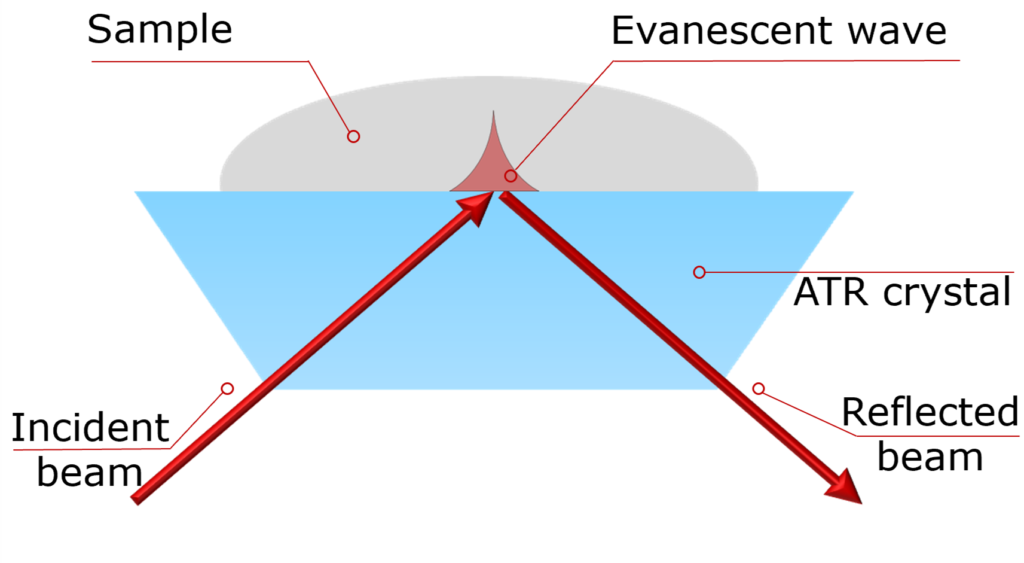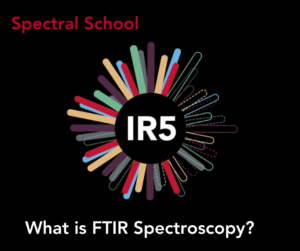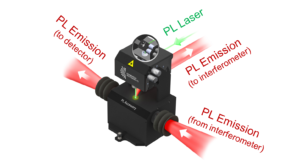Fourier Transform Infrared (FTIR) Spectroscopy is the most commonly used form of IR spectroscopy and an extremely powerful tool in analytical, industrial, and academic laboratories. There are several FTIR sampling techniques available, with the most common being transmission, attenuated total reflectance (ATR), specular reflectance and diffuse reflectance. The design of an FTIR spectrometer also lends itself to Fourier transform photoluminescence (FT-PL) measurements in the mid-IR (MIR) spectral range broadening the analysis possible with an FTIR spectrometer. In this article the working principle, advantages and appropriate sample types for each sampling technique are discussed.
Transmission FTIR spectroscopy is the most traditional method to analyse samples. Incident infrared light passes through the sample, and the amount which transmits through is measured producing an FTIR spectrum in %Transmission.

Figure 1: Transmission
Transmission FTIR can be used for liquids, solids, and gases. Whilst still being a commonly used technique, and essential for gas measurements, the limitations of transmission FTIR has resulted in it no longer being the most favourable sampling technique for solids and liquids. ATR-FTIR has replaced transmission FTIR as the standard sampling technique.
Sample preparation is typically required for transmission measurements, solid samples may require dispersion in KBr and pressed into pellets, and IR transparent windows, such as CaF2, are required for measuring liquids. Placement of samples in such a way can result in non-reproducible spectra due to inconsistency in where the IR beam hits the sample.
ATR-FTIR is the dominant FTIR method for analysis of solids and liquids as it requires little to no sample preparation and is non-destructive. With ATR-FTIR an Internal Reflective Element (IRE) is used as the ATR crystal that the beam of radiation is directed into. This must have a high refractive index, higher than that of the sample, to prevent the beam going through the sample. When the light is shone into the IRE and is totally reflected from its internal surface, an evanescent wave is created that projects orthogonally into the sample, Figure 2. The sample absorbs a certain amount of energy, and the evanescent wave becomes attenuated. The attenuated beam is reflected out of the IRE and to the detector.
Figure 2: Attenuated Total Reflectance
To obtain a spectrum there must be contact between the sample and the crystal, as such ATR sampling accessories will have a clamping arm to apply pressure to solids ensuring consistent contact between sample and crystal.
A range of materials are available for the ATR crystal, and the decision of which one to pick is based on application area. ZnSe is suitable for routine analysis, however harder samples can cause the crystal to crack or shatter and strongly acidic or basic samples can cause toxic fumes. Germanium is suited to samples with a high refractive index and surface studies due to its smaller depth of penetration. Diamond is the gold standard material for ATR crystals; it’s virtually indestructible, whilst offering high thermal conductivity for heated ATR-FTIR experiments.
Specular reflectance is an external reflectance technique, making them different to ATR which relies on internal reflection. In specular reflectance the angle of incidence equals the angle of reflection. The technique is used for smooth surfaces of solids and is particularly useful for thin films on reflective substrates, bulk material analysis, and monolayer analysis. This type of sampling accessory can also measure transmission-reflectance (transflectance) spectra from samples which are coated on a metal surface. The spectrum contains information from the surface of the coating, as well as the metal surface underneath. This method is most useful for measuring protective coatings on metal surfaces.
Figure 3: Specular reflectance.
Diffuse reflectance infrared Fourier transform spectroscopy (DRIFTS) is a second external reflectance technique used for collecting IR spectra from strongly absorbing samples with rough surfaces, such as powders. The IR incident beam penetrates into the sample and subsequently scatters in all directions. The main application area of DRIFTS is qualitative analysis of powders in pharmaceutical and forensic laboratories. Specific reflection accessories are available for both of these FTIR sampling techniques.
Figure 4: Diffuse reflectance.
An FTIR spectrometer can also be configured to measure photoluminescence (PL) spectra in the mid-infrared region. For this measurement an excitation laser is required, which is directed onto the sample. The sample’s PL emission is then directed into the interferometer and through to the detector. This technique is mainly used to look at MIR photoluminescence of rare-earth’s and semiconductors.
Figure 5: FT-PL Sampling accessory for Edinburgh Instruments IR5.
Table 1: Sampling Techniques Summary
FTIR spectroscopy is an extremely versatile technique with a sampling accessory to fit every application. The IR5 FTIR Spectrometer is designed to accommodate a wide range of sampling techniques to suit every laboratory, from commonly used methods such as ATR-FTIR to sampling accessories to expand the FTIR spectrometers use, such as FT-PL.


